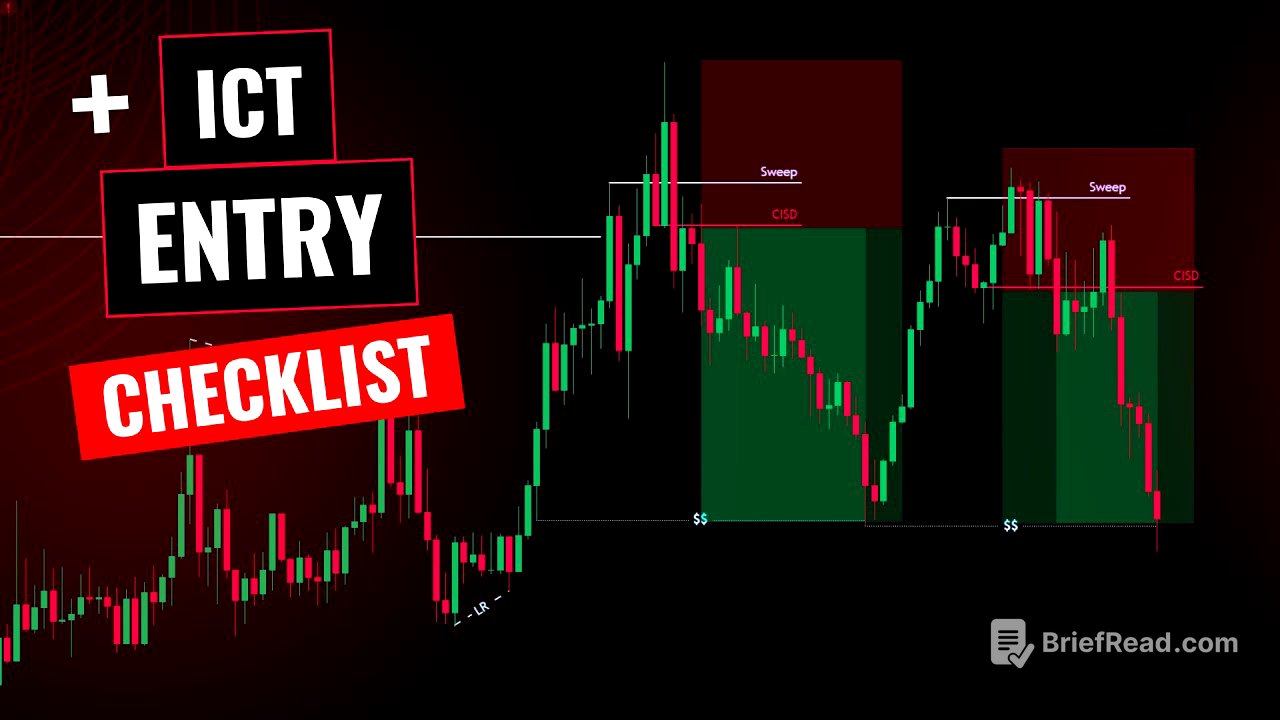TLDR;
This video provides a detailed checklist for entering trades using Smart Money Concepts (SMC) and ICT (Inner Circle Trader) strategies. It emphasizes identifying key levels, waiting for price to reach those levels, and confirming entries with specific criteria like failure to displace and Change in State of Delivery (CISD). The checklist aims to increase confidence and precision in trading by eliminating guesswork and providing a structured approach to entries, stop-loss placement, and target setting.
- Mark key levels such as swing highs/lows, higher time frame candle highs/lows, and fair value gaps.
- Wait for the price to reach these key levels before considering a trade.
- Look for specific entry criteria, including failure to displace and CISD confirmation.
Introduction [0:00]
The video introduces a step-by-step checklist designed to improve trading entries using Smart Money Concepts (SMC) and ICT strategies. The aim is to help traders avoid common pitfalls such as getting faked out, entering trades too early or late, and experiencing hesitation and doubt. The checklist provides a structured approach to identify high-probability entries with precision.
Step 1: Mark Out Key Levels [1:47]
The first step involves identifying and marking key levels on the chart. These levels include swing highs and lows, which act as liquidity pools. Traders should also mark the highs and lows of higher time frame candles (4-hour, daily, or weekly) as potential areas of interest. Fair Value Gaps (FVG), which are imbalances left behind during price displacement, are also important key levels to mark for potential entries or exits.
Step 2: Wait for Price to Come to the Key Level [4:15]
This step emphasizes the importance of patience and waiting for the price to reach the identified key levels before considering a trade. It highlights that many traders lose money by entering trades prematurely, before the price interacts with these levels. Examples are provided to illustrate how price reacts when it reaches swing highs, higher time frame candle highs/lows, and fair value gaps, signaling potential entry points.
Step 3: Looking for Entry Criteria [5:28]
The third step details the specific criteria to look for when the price reaches a key level. The first criterion is "failure to displace" on a higher time frame (daily, 4-hour, or 1-hour), indicating rejection at the key level. Once this pattern is observed, traders should drop to a lower time frame (5-minute or 15-minute) and identify the Change in State of Delivery (CISD) level. The CISD helps determine when the market is likely to shift from bullish to bearish or vice versa.
Understanding and Identifying CISD [7:32]
CISD, or Change in State of Delivery, indicates potential shifts in market direction. It involves identifying manipulation runs where price aggressively sweeps highs or lows, taking out stop losses. The CISD level is marked at the candle or series of candles that cause this manipulation. A break of this level confirms the manipulation and signals a potential entry. Examples are provided for both bearish and bullish scenarios, illustrating how to identify the CISD and use it for entry confirmation.
Stop Loss Placement and Target Setting [9:51]
The video explains how to set stop losses and targets based on the entry checklist. Stop losses should be placed just beyond the manipulation point (e.g., above the swing high in a bearish scenario) to avoid being taken out by further manipulation. Targets can be set at swing lows, higher time frame candle lows, or fair value gaps where sell-side liquidity is resting.
Live Trade Example [10:16]
A live trade example on a cryptocurrency token is presented to demonstrate the application of the entry checklist. The trader identifies a swing high on the 4-hour chart and waits for the price to reach that level. Upon arrival, a failure to displace pattern is observed, signaling a potential reversal. The trader then drops to the 15-minute time frame, identifies the CISD level after a manipulation run, and enters the trade when the price breaks below the CISD. The stop loss is placed above the swing high, and the target is set at a lower fair value gap.









